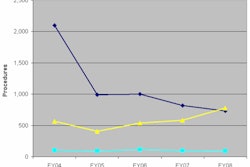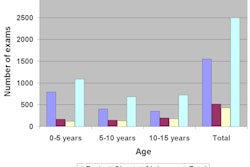When a child with a serious head injury is admitted to a hospital in the state of Washington, there's a strong possibility that a CT scan will be ordered. But whether a low radiation dose will be used still remains uncertain, according to a study published in the April issue of the Journal of the American College of Radiology.
A survey to evaluate the consistency of low-dose protocols for pediatric head CT exams at trauma centers throughout the state revealed a lot of variety. Based on these findings, the University of Washington researchers are now working on a statewide campaign to adopt dose reduction protocols as recommended by the Image Gently campaign (2011, JACR, Vol. 8:4, pp. 242-250).
The project's developers hypothesized that even though most trauma centers in the state used multislice CT scanners and their radiology departments were aware of the Image Gently campaign, variation in adoption of low-dose protocols might exist, especially among trauma centers at different levels. To test this hypothesis, they developed and sent a short survey to 77 trauma centers.
Seventy-six percent of the survey recipients responded, including the state's only level I and its four level II trauma centers. In addition, 70% of the level III and IV trauma centers responded, as well as 44% of the level V centers.
As might be expected, the level I trauma center, University of Washington-affiliated Harborview Medical Center, was the first hospital in the state to implement pediatric radiation dose reduction strategies in 2001. The majority of level III trauma centers did the same in 2004. Interestingly, the level II trauma centers did not implement dose reduction strategies until 2007, but when they did, they used the lowest reported effective dose for the study's hypothetical patient, a female infant (57-cm long, weighing 4.2 kg).
In 2007, if a child sustained a major head injury in Washington, he or she had the greatest likelihood (36.3%) of receiving a head CT exam at a level IV trauma center, where the reported radiation dose to the brain ranged from 7.0 to 123.8 mGy (median, 37 mGy), according to lead author Kalpana Kanal, PhD, a medical physicist and associate professor of radiology, and colleagues. There was more than a 10-fold variation in the estimated median effective dose that the hypothetical infant would receive at these level IV centers.
While most trauma centers reported having pediatric-specific head CT protocols, a greater proportion of level III, IV, and V trauma centers collectively lacked dose reduction strategies and reported higher mAs. More than 56% of the 2,215 children who had a head CT performed in 2007 had their exam performed at one of these hospitals.
The eight pediatric hospitals in the state were more dose conscious and used statistically significant lower mAs settings compared to adult-designed centers, the authors wrote.
As a result of the survey, the University of Washington research team is trying to persuade the state government to establish regulations on dose and image quality for pediatric head CT imaging, Kanal told AuntMinnie.com. She said that in late 2010 the state distributed a brochure to hospitals recommending steps for optimizing radiation exposure from CT exams.
Kanal and colleagues have also prepared an educational tool with modules on CT dose reduction that are designed primarily for CT technologists and will be distributed by the state. The modules will also be posted online, and they will be made available for technologists to receive continuing education credit through the American Society of Radiologic Technologists (ASRT). The researchers plan to conduct a follow-up study a year after the modules are distributed.
"We think that this study was very important because it shows the degree of unawareness and lack of education about imaging pediatric patients," Kanal said. She and her colleagues encourage radiologists and medical physicists in other states to conduct the same type of survey on behalf of the long-term health of pediatric patients.
"Conducting a survey like the one we developed may be a wake-up call that more needs to be done to protect our vulnerable pediatric patients. It was for us, and we are doing something about it," Kanal concluded.



















